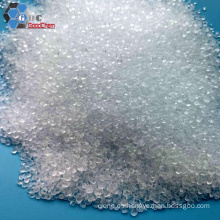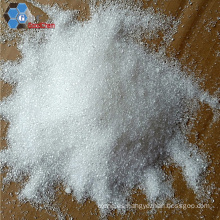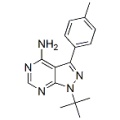.cp_wz tabla {borde superior: 1px sólido #ccc; borde izquierdo: 1px sólido #ccc; } .cp_wz table td {borde derecho: 1px sólido #ccc; borde inferior: 1px sólido #ccc; padding: 5px 0px 0px 5px;} .cp_wz table th {border-right: 1px solid #ccc; border-bottom: 1px solid #ccc; relleno: 5px 0px 0px 5px;} \ n Peso molecular: \ n 281.36 PP1 es un inhibidor de Src potente y selectivo para Lck / Fyn con IC50 de 5 nM / 6 nM. \ n Actividad biológica PP1 es un inhibidor nano-molar de Lck y FynT, inhibe la actividad de la proteína tirosina quinasa inducida por anti-CD3 en las células T (IC50, 0,5 μM), demuestra selectividad para Lck y FynT sobre ZAP-70 e inhibe preferentemente las células T inducidas por anti-CD3 dependientes del receptor de células T proliferación (IC50, 0,5 µM) sobre la proliferación de células T inducida por 12-miristato 13-acetato / interleu-kin-2 (IL-2) no dependiente del receptor de células T. PP1 (1 µM) inhibe selectivamente la inducción del gen IL-2, pero no el factor estimulante de colonias de granulocitos-macrófagos o los genes del receptor de IL-2. PP1 también inhibe Src (IC50, 170 nM) y Hck (IC50, 20 nM). PP1 es 50 a 100 veces menos activo en la inhibición de la autofosforilación del receptor del factor de crecimiento epidérmico A-431 (IC50, 0,25 μM). [1] PP1 también inhibe las tirosina quinasas Kit y Bcr-Abl con IC50 de ~ 75 nM y 1 μM, respectivamente. PP1 anula por completo la proliferación de células M07e en respuesta a SCF con IC50 de 0,5 a 1 μM. PP1 (1 μM) inhibe la autofosforilación de c-Kit inducida por SCF en células intactas y bloquea la activación de la proteína quinasa activada por mitógenos y Akt. PP1 inhibe la actividad de formas mutantes constitutivamente activas de c-Kit (D814V y D814Y) que se encuentran en trastornos de mastocitos y desencadena la apoptosis en la línea celular de leucemia basófila de rata RBL-2H3 que expresa c-Kit mutante. PP1 reduce la activación constitutiva del transductor de señal y los activadores de la transcripción 5 y la proteína quinasa activada por mitógenos y desencadena la apoptosis en las células FDCP1 que expresan Bcr-Abl. [2] Protocolo (solo como referencia) Ensayo de quinasa: [1]
|
Immune complex enzyme assays
|
The acid-treated enolase is diluted 1:20 with 1× PBS before aliquoting 100 mL/well into a Nunc 96-well high protein binding assay plate. Assay wells are then aspirated; blocked with 0.5% bovine serum, 1× PBS for 1 h at 37 ℃;and then washed five times with 300 mL of 1× PBS/well. The source of Lck is either LSTRA cells or Lck expressed in HeLa cells using a vaccinia expression system. FynT is expressed in HeLa cells using the vaccinia system. Cells (12.5× 106/mL) are lysed in lysis buffer (20 mM Tris, pH 8.0, 150 mM NaCl, 0.5% Nonidet P-40, and 23 trypsin inhibitory units/mL aprotinin), and the lysates are clarified by centrifugation at 14,000 cpm for 15 min at 4 ℃ in an Eppendorf tube. The clarified lysates are then incubated with the appropriate anti-kinase antibody at 10 μg/mL for 2 h at 4 ℃. Protein A-Sepharose beads are added to the antibody/lysate mixture at 250 μL/mL and allowed to incubate for 30 min at 4 ℃. The beads are then washed twice in 1 mL of lysis buffer and twice in 1 mL of kinase buffer (25 mM HEPES, 3 mM MnCl2, 5mM
MgCl2, and 100 μM sodium orthovanadate) and resuspended to 50% (w/v) in kinase buffer. Twenty-five microliters of the bead suspension is added to each well of the enolase-coated 96-well high protein binding plate together with an appropriate concentration of compound and [γ-32P]ATP (25 μL/well of a 200 μCi/mL solution in kinase buffer). After incubation for 20 min at 20 ℃, 60 μLl of boiling 2× solubilization buffer containing 10 mM ATP is added to the assay wells to terminate the reactions. Thirty microliters of the samples is removed from the wells, boiled for 5 min, and run on a 7.5% SDS-polyacrylamide gel. The gels are subsequently dried and exposed to Kodak X-AR film. For quantitation, films are scanned using a Molecular Dynamics laser scanner, and the optical density of the major substrate band, enolase p46, is determined. In companion experiments for measuring the activity of compounds against Lck, the assay plate is washed with two wash cycles on a Skatron harvester using 50 mM EDTA, 1 mM ATP. Scintillation fluid (100 μL) is then added to the wells, and 32P incorporation is measured using a micro-β-counter.
|
Conversión de diferentes modelos de animales basados en BSA (valor basado en datos del Borrador de Directrices de la FDA)
|
Species
|
Baboon
|
Dog
|
Monkey
|
Rabbit
|
Guinea pig
|
Rat
|
Hamster
|
Mouse
|
|
Weight (kg)
|
12
|
10
|
3
|
1.8
|
0.4
|
0.15
|
0.08
|
0.02
|
|
Body Surface Area (m2)
|
0.6
|
0.5
|
0.24
|
0.15
|
0.05
|
0.025
|
0.02
|
0.007
|
|
Km factor
|
20
|
20
|
12
|
12
|
8
|
6
|
5
|
3
|
|
Animal A (mg/kg) = Animal B (mg/kg) multiplied by
|
Animal B Km
|
|
Animal A Km
|
Por ejemplo, para modificar la dosis de resveratrol utilizada para un ratón (22,4 mg / kg) a una dosis basada en el BSA para una rata, multiplique 22,4 mg / kg por el factor Km para un ratón y luego divida por el factor Km para una rata. Este cálculo da como resultado una dosis equivalente para ratas de resveratrol de 11,2 mg / kg.
|
Rat dose (mg/kg) = mouse dose (22.4 mg/kg) ×
|
mouse Km(3)
|
= 11.2 mg/kg
|
|
rat Km(6)
|
Información química
|
Molecular Weight (MW)
|
281.36
|
|
Formula
|
C16H19N5
|
|
CAS No.
|
172889-26-8
|
|
Storage
|
3 years -20℃Powder
|
|
6 months-80℃in solvent (DMSO, water, etc.)
|
|
Synonyms
|
AGL 1872,EI 275
|
|
Solubility (25°C) *
|
In vitro
|
DMSO
|
4 mg/mL
(14.21 mM)
|
|
Water
|
<1 mg/mL
(
|
|
Ethanol
|
<1 mg/mL
(
|
* <1 mg/ml means slightly soluble or insoluble.
* Please note that Selleck tests the solubility of all compounds in-house, and the actual solubility may differ slightly from published values. This is normal and is due to slight batch-to-batch variations.
|
|
Chemical Name
|
1H-Pyrazolo[3,4-d]pyrimidin-4-amine, 1-(1,1-dimethylethyl)-3-(4-methylphenyl)-
|
Calculadora de molaridad Calculadora de dilución Calculadora de peso molecular
Grupos de Producto : Angiogénesis > Inhibidor Src








